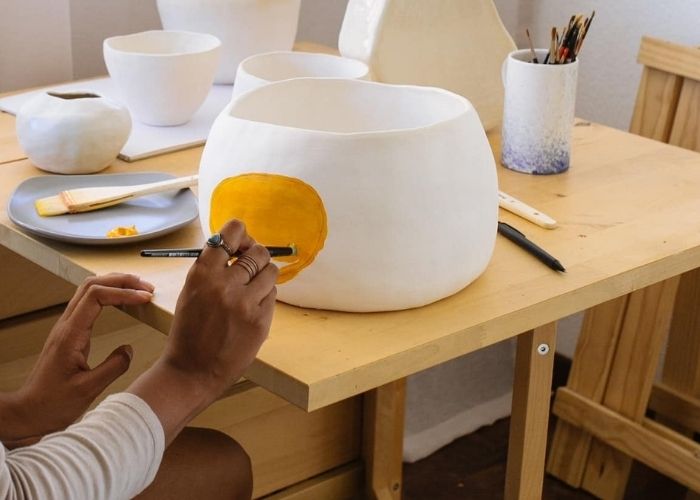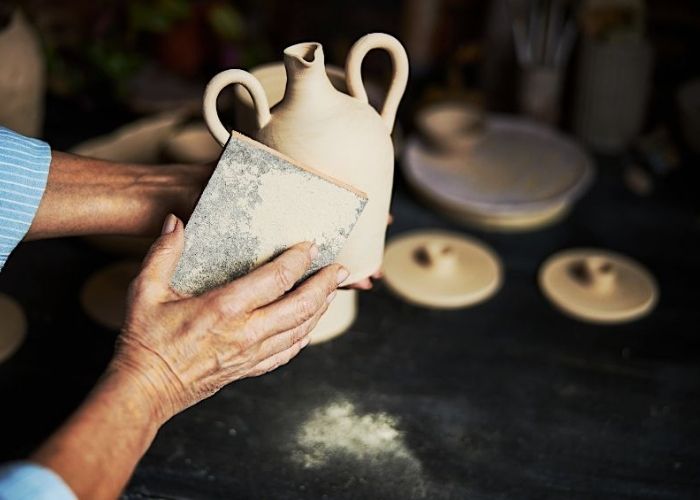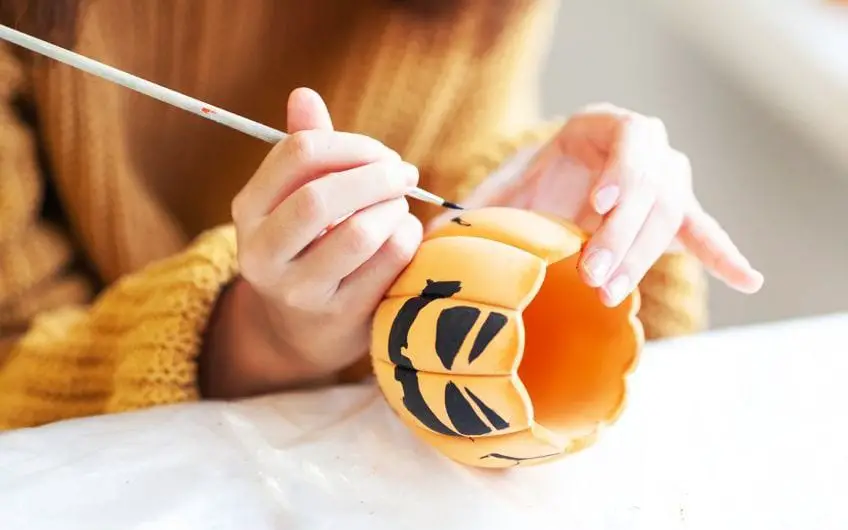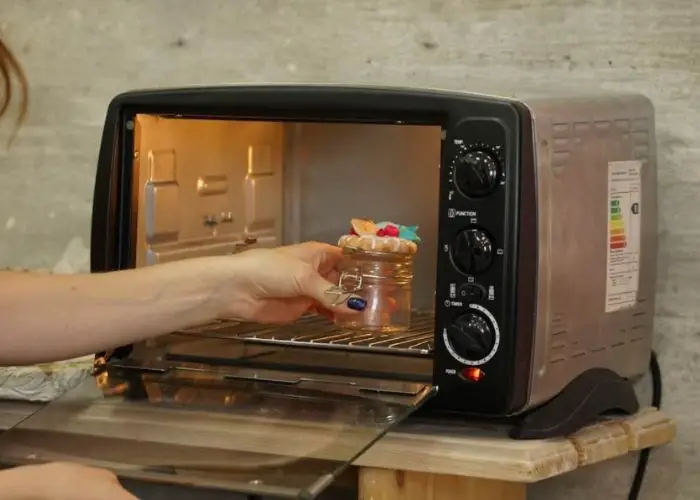Acrylic paint can be used for many different purposes. It can be used for painting, crafting, and even baking. So, Can you bake acrylic paint? The answer is yes.
But you need to know a few things before you bake acrylic paint. First, you need to use a baking sheet lined with foil or parchment paper.
This will prevent the paint from sticking to the baking sheet. Second, you need to preheat your oven before you bake the paint.
To help the paint to set properly. Finally, you need to make sure that the paint is completely dry before baking it.
Once you have all of your supplies, you are ready to bake your acrylic paint. Here are a few tips to help you get started.
Can You Bake Acrylic Paint?
Yes, you can bake acrylic paint to create various effects. Baking acrylic paint is a great way to add texture and dimension to your artwork. It can also be used to create unique home decor on items such as ceramic mugs, glass, metal, etc.
Can You Bake Acrylic Paint on Ceramic
Acrylic paint can be used on ceramic, but it must be sealed with a clear acrylic sealer before you bake it.
This will help prevent the paint from chipping or peeling off the surface. When baking, place the ceramic piece on a baking sheet and set it to the lowest temperature possible.
This will help to prevent the paint from cracking or bubbling. Then, once the piece is cool, it can be used as usual.
Keep in mind that baked acrylic paint is not as durable as other types of paints such as enamel paint and oil paint, so it may need to be reapplied more often.
Plus, don’t paint over enamel with acrylic unless you remove the paint first or use a suitable primer.
Why Seal Acrylic Paint on Ceramic?

Acrylic paint is a water-based paint, making it ideal for painting on ceramic. However, sealing acrylic paint is important before you start painting.
This will help to prevent the bake paint from chipping and peeling over time. There are two main types of sealers: water-based and oil-based.
Water-based sealers are typically easier to apply, but they may not be as durable as oil-based sealers. Oil-based sealers can be more difficult to apply, but they tend to be more durable and provide a better finish.
Whichever type of sealer you choose, follow the instructions carefully and allow the paint to dry completely before using the ceramic piece.
With a little effort, you can create a beautiful and unique piece of art with acrylic paint on ceramic.
How to Seal Acrylic Paint on a Ceramic Mug or Plate
Although ceramic mugs and plates are durable, they are not impervious to damage. Acrylic paint, for example, can easily chip or scratch off the surface if it is not properly sealed.
If you want to decorate a ceramic mug or plate with acrylic paint, you can take a few simple steps to ensure that your design will last.
Step 1: Clean the surface of the mug or plate with soap and water. This will remove any dirt or residue that could prevent the paint from adhering properly.
Step 2: Apply a layer of primer to the surface. This will create a smooth base for the paint to adhere to. Once the primer is dry, you can begin acrylic painting your design. Use acrylic paint specifically designed for use on ceramic.
Step 3: Once your design is complete, allow the paint to dry completely. Then, apply a layer of clear sealer to the surface. This will protect the paint and help to prevent chipping or scratching. Again, allow the sealer to dry completely before using the mug or plate.
Can You Bake Acrylic Paint in the Oven?
Yes and No. You can technically bake acrylic paint in the oven, but it will not have the same effect as baking other types of paints.
It will not become permanently set or waterproof when you bake acrylic paint. However, it can help to speed up the drying process and make the paint more durable.
There are a few things to keep in mind when baking paint. First, make sure the paint is oven-safe. Some acrylic paints may not be suitable for baking, so it’s important to check the label before proceeding.
Second, the bake time will vary depending on the thickness of the paint and the desired result.
For example, if you’re looking to set the paint so that it’s dishwasher-safe, you’ll need to bake it for a longer period of time than if you’re simply trying to dry the paint.
Finally, remember that baked paint will be more brittle than unbaked paint, so be careful when handling it.
How to Bake Acrylic Paint on Ceramic in the Oven
Baking acrylic paint on ceramic is a great way to ensure that your paint job lasts. The heat from the oven will help set the paint and make it more durable. Here’s how to do it:
Step 1: Clean the surface
Clean your ceramic piece thoroughly with soap and water. This will remove any dirt or grime that could prevent the paint from adhering properly.
Step 2: Allow the paint to dry
Paint your ceramic piece with acrylic paint and allow it to dry completely. This may take several hours, or you can use a hairdryer or a cool oven to speed up the process.
Step 3: Place the ceramic in the oven
Preheat your oven to 300 degrees Fahrenheit. Then, place the ceramic piece on a baking sheet and put it in the oven.
Step 4: Bake the ceramic
Bake the ceramic for 30 minutes. This will help set the paint and make it more durable. After 30 minutes, turn off the oven and allow the piece to cool completely before handling.
How to Remove Acrylic Paint from Ceramic

Acrylic paint is water-based; it can be difficult to remove once it dries. However, if you need to remove acrylic paint from ceramic, you can use a few simple methods.
One way to remove acrylic paint from ceramic is to soak the piece in warm soapy water. This will help to loosen the paint and make it easier to remove.
Another option is using a putty knife or other sharp object to scrape the paint off the surface. Finally, if the paint refuses to budge, you can try using a chemical stripper.
However, be sure to use caution when handling chemicals and follow the instructions carefully.
Is It Safe to Bake Acrylic Paint in the Oven?
Yes, you can bake acrylic paint in the cool oven. However, it’s important to note that the paint will not become permanently set or waterproof.
The oven’s heat will help set the paint and make it more durable, but it’s not a cure-all solution. As always, be sure to use caution when heating chemicals in the oven.
Read more to find out if acrylic paint is safe for kids.
Can You Bake Acrylic Paint on Porcelain?
You can bake acrylic paint on porcelain. First, however, you need to ensure that the paint is designed for baking, as not all acrylic paints are oven-safe.
You’ll also want to use a porcelain baking dish or plate, as other types of dishes may not withstand the high temperatures required for baking paint.
Once you’ve prepared your materials, follow the instructions on the paint can or package to bake your paint.
Can You Bake Acrylic Paint on Polymer Clay?
Yes, acrylic paint may be used on polymer clay before it has been baked; however, you cannot use acrylic paints after baking.
You can use acrylic paint before you bake the clay because the heat from baking will set the paint and make it permanent.
However, if you try to paint polymer clay after it has been baked, the paint will not adhere properly and will likely peel off.
Can You Bake Acrylic Paint on Metal?
Most people would say no, you can’t bake acrylic paint on metal. However, some people have had success with this method.
The key is to make sure that the metal is clean and free of grease or dirt. You also need to use high-quality acrylic paint.
If you’re not sure whether or not your paint will work, it’s always best to test it on a small area first. Once you’ve prepped the metal, you can then bake it in the oven at a low temperature for a few minutes.
This will help the paint to set and dry. Just keep an eye on it so that it doesn’t start to smoke!
Can You Bake Acrylic Paint on Glass
You can bake acrylic paint on glass, but it needs to be done carefully. Also, know how to get paint off of glass when it’s time to remove or change it.
First, make sure the paint is fully dry. It could start to bubble and blister in the oven if it’s even slightly wet. Here’s how to paint glass with acrylic paint properly.
Next, preheat your oven to the lowest temperature possible. Then, place the glass on a baking sheet and put it in the oven.
Bake for 30 minutes, then remove from the oven and allow to cool completely. Once cooled, your design should be permanent. You can decide to protect it further by sealing it. Here is how to seal painted glass.
How to Bake Acrylic Paint on Glass
- Set the oven to 375 degrees Fahrenheit and preheat for about 20 minutes.
- Place the glass baking dish with the painted side up on a wire rack.
- Bake for 30 minutes. Let the glass cool completely on a wire rack before using.
- The paint is now permanent and can be washed with soapy water or put in the dishwasher.
Can You Bake Acrylic Paint on Wood
Acrylic paint can be baked on wood to create a durable and long-lasting finish. In addition, the paint will adhere to the wood and not chip or peel over time.
Baked acrylic paint is also resistant to staining and fading. To bake acrylic paint on wood, first sand the surface of the wood to create a smooth base.
Next, apply a base coat of primer to the wood. Once the primer is dry, apply a thin layer of acrylic paint to the wood. Use a paint designed for use on wood surfaces.
Finally, bake the painted wood in a preheated oven for 30 minutes. After the time has elapsed, remove the wood from the oven and allow it to cool completely.
Can You Bake Acrylic Paint on Plastic

can you bake acrylic paint on plastic? The answer is yes, you can. Many people recommend it to ensure that your paint job lasts.
However, there are a few things you need to know before you start baking your paint. First, make sure that the paint is compatible with the plastic.
Some types of paint can damage the plastic when heated, so it’s important to do your research beforehand. Second, be sure to heat the paint slowly and evenly.
Sudden temperature changes can cause the paint to crack or peel, so it’s important to take your time. Finally, make sure that you allow the paint to cool completely before handling the plastic.
This baking method can be used on various plastic items, including storage containers, coffee mugs, and keychains.
Can You Bake Acrylic Paint on Salt Dough
Yes. You can use a low-heat oven to carefully bake your salt dough project with acrylic paint to help set the paint.
First, mix the salt dough according to the recipe you are using. Once the dough is mixed, knead in a small amount of flour if it is too sticky.
Then, roll out the dough onto a floured surface and use a cookie cutter to cut out shapes. Place the cutouts on a baking sheet lined with parchment paper.
Next, use a thin paintbrush to paint the cutouts with acrylic paint. Use thin layers of paint so that the colors do not run together when you bake them.
Finally, bake the salt dough in a preheated oven at a low temperature for 30 minutes. Allow the salt dough to cool completely before handling.
Can You Bake Acrylic Paint on a Mug
Yes. Acrylic paint can withstand temperatures of up to 300 degrees Fahrenheit without losing its color or finish.
Therefore, baking your ceramic mugs with a design made from acrylic paint is a great way to set the design and prevent it from chipping or fading over time.
Just follow the directions on the paint can carefully, as some brands may require a different baking temperature or time.
If you’re not sure, err on the side of caution and bake your mug at a lower oven temperature for a longer time.
Bakeable Acrylic Paint
Bakeable acrylic paint is a type of paint that can be baked to set it. This type of paint is commonly used for crafting and other projects where a permanent finish is desired.
Bakeable acrylic paint is available in a wide variety of colors, and it can be mixed to create custom shades.
Bakeable acrylic paint can be applied to a variety of surfaces, including glass, ceramic, metal, and plastic.
What You Can Use Bakeable Paint Onto?
Bakeable paint can be used on a variety of surfaces, including glass, ceramic, metal, and stone. It is ideal for creating durable and long-lasting designs on bakeware, vases, ornaments, and even jewelry.
When baked, the paint will set and become dishwasher-safe, making it a great option for pieces that will be used often.
And because it doesn’t require firing in a kiln, bakeable paint is much easier to use than traditional ceramic paints.
So whether you’re looking to add a personal touch to your kitchenware or want to create a one-of-a-kind gift, bakeable paint is a great option.
Painting Plates with Acrylic Paint
Painting plates with acrylic paint is a really fun way to get creative and make some really unique pieces of art. You can paint designs, patterns, or even words on your plates.
Here are a few tips to help you get started:
- Choose the right type of paint. Acrylic paint is the best type to use for painting plates, because it dries quickly and is easy to clean up.
- Choose a bright and bold color scheme. Painting plates with bright colors is the best way to make them stand out.
- Use a thin brush for detail work.
How to Bake Bakeable Acrylic Paint
Most people think that it’s there forever once you paint something with acrylic paint. However, there is a way to bake the paint onto a surface to become permanent.
This process is called “baking,” and it produces a much harder and more durable finish than simply letting the paint air dry. Baking also prevents the paint from chipping or peeling over time.
To bake your paint, start by preheating your oven to the manufacturer’s recommended oven temperature—next, lay out your work area to have plenty of space to work.
Then, using a brush or roller, apply an even layer of paint to your chosen surface. Once the paint is applied, place the item in the oven and bake for the recommended amount of time.
Finally, remove the item from the oven and allow it to cool completely before using.
Is Acrylic Paint Dishwasher Safe?
Yes, acrylic paint is dishwasher safe. However, there are a few things that you need to keep in mind when washing your dishes that are painted with acrylic paint.
First, you need to make sure that the paint is fully dry before putting it in the dishwasher. If the paint is not dry, it could cause the dishwasher to clog.
Secondly, you need to use a mild detergent when washing your dishes with acrylic paint. Using a harsh detergent could damage the paint.
Finally, you need to ensure that the dishwasher is set to a low-temperature setting. A high-temperature setting could cause the paint to blister or peel.
Read More: Can You Burn Acrylic Paint
FAQs
What temperature can acrylic paint withstand?
One thing to consider when using acrylic paint is the temperature at which it can be safely used. Acrylic paint is safe at up to 100 degrees. However, if you plan to use it at a higher temperature, you should test it first to ensure it will not melt or warp the surface on which you are using it.
Is acrylic paint toxic when heated?
Acrylic paint is non-toxic and can be used in a variety of applications, including fine art, illustration, and graphic design. But when heated, it will produce fumes that can be harmful if inhaled.
Conclusion
I hope this article has shown you that with a bit of know-how, experimentation, and courage, you can bake acrylic paint.
It’s not as scary as it seems – take your time, be patient, and have fun with it.
And if all else fails, there are always YouTube videos to help get you through the tough moments. So what are you waiting for? Get in the kitchen and start baking!











Leave a Reply